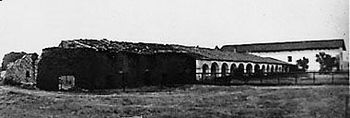Mission San Miguel Arcángel
- Another mission bearing the name San Miguel Arcángel is the Misión San Miguel Arcángel de la Frontera in Baja California.
Mission San Miguel Arcángel was founded on July 25, 1797 by the Franciscan order, on a site chosen specifically due to its proximity to the large number of Salinan Indians that inhabited the area.
 The "Mission on the Highway" circa 1910.[1] The "Mission on the Highway" circa 1910.[1]
| |
| HISTORY | |
|---|---|
| Location: | San Miguel, California |
| Name as Founded: | La Misión del Gloriosísimo Príncipe Arcángel, Señor San Miguel [2] |
| English Translation: | The Mission of the Glorious Prince, Archangel Saint Michael |
| Patron Saint: | Archangel Saint Michael [3] |
| Nickname(s): | "Mission on the Highway" [4] "The Unretouched Mission" [5] |
| Founding Date: | July 25,1797 [6] |
| Founded By: | Father Fermín Lasuén [7] |
| Founding Order: | Sixteenth [3] |
| Military District: | Third [8] |
| Native Tribe(s): Spanish Name(s): |
Salinan |
| Primordial Place Name(s): | Valica [9] |
| SPIRITUAL RESULTS | |
| Baptisms: | 4,340 [10] |
| Confirmations: | 2,471 [10] |
| Marriages: | 764 [10] |
| Burials: | 1,868 [10] |
| DISPOSITION | |
| Secularized: | 1834 [3] |
| Returned to the Church: | 1859 [3] |
| Governing Body: | Roman Catholic Diocese of Monterey |
| Current Use: | Parish Church (under repair) |
| Coordinates: | 35°44′41″N, 120°41′53″W |
| National Historic Landmark: | #NPS-71000191 |
| Date added to the NRHP: | July 14, 1971 |
| California Historical Landmark: | #326 |
| Web Site: | http://www.missionsanmiguel.org/ |
Precontact
History
In 1846, Governor Pío Pico sold the Mission for $600 to Petronillo Rios and William Reed. Reed used the Mission as a family residence and a store. In 1848, Reed and his family were murdered, leaving the Mission vacant for a period of time. The Mission was a stopping place for miners coming from Los Angeles to San Francisco, and was consequently was used as a saloon, dance hall, storeroom and living quarters.
In 1878, after 38 years without a resident padre, Father Philip Farrelly became the "First Pastor" of Mission San Miguel Arcángel. Through all the years the priests kept the church in condition and it is called the best-preserved church in the mission chain today. In 1928, Mission San Miguel Arcángel and Mission San Antonio de Padua were returned to the Franciscan order. Since then, the Mission has been repaired and restored, and has one of the best-preserved interiors (which gives one of the best examples of old mission life).
For many years, the Mission served the town as an active parish church of the Roman Catholic Diocese of Monterey in California. Unfortunately, harmonic vibrations from the nearby Union Pacific Railroad main line has weakened the unreinforced masonry structures over the years. The San Simeon Earthquake of December 22, 2003 caused severe damage to the sanctuary at Mission San Miguel. It will be a several years before seismic retrofitting of the structure (estimated to cost some $15 million) will be completed; until then, the building is off-limits to the general public.[11]
Mission bells
Bells were vitally important to daily life at any mission. The bells were rung at mealtimes, to call the Mission residents to work and to religious services, during births and funerals, to signal the approach of a ship or returning missionary, and at other times; novices were instructed in the intricate rituals associated with the ringing the mission bells.
Notes
- ↑ (PD) Photo: William Amos Haines
- ↑ Leffingwell, p. 91
- ↑ 3.0 3.1 3.2 3.3 Krell, p. 254
- ↑ Engelhardt
- ↑ Ruscin, p. 129
- ↑ Yenne, p. 140
- ↑ Ruscin, p. 196
- ↑ Forbes, p. 202
- ↑ Ruscin, p. 195
- ↑ 10.0 10.1 10.2 10.3 Krell, p. 315: as of December 31, 1832; information adapted from Engelhardt's Missions and Missionaries of California.
- ↑ Coronado and Ignatin